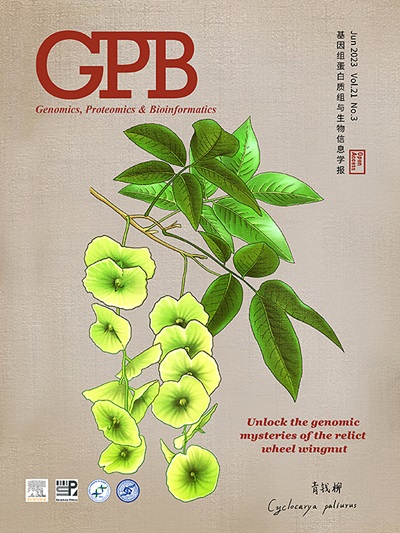通过 STARR-seq 鉴定具有长程调控潜力的高度重复大麦增强子
IF 7.9
2区 生物学
Q1 GENETICS & HEREDITY
引用次数: 0
摘要
摘要 增强子是能够加强转录启动的 DNA 序列。然而,由于增强子的距离和方向不确定,植物增强子的全球鉴定非常复杂,尤其是在基因组较大的物种中。在这项研究中,我们首次进行了自转录活性调控区测序(STARR-seq),以鉴定大麦基因组中的增强子。共成功鉴定出7323个增强子,在随机选择的45个增强子中,超过75%的增强子通过烟草叶片下表皮的双荧光素酶报告检测系统验证是有效的。有趣的是,高达53.5%的大麦增强子是重复序列,尤其是转座元件(TE),从而加强了重复增强子在基因表达中的重要作用。在大麦 STARR-seq 增强子中,常见的活性转录标记 H3K4me3 和抑制性组蛋白标记 H3K27me3 都很丰富。此外,与水稻和玉米相比,大麦 STARR-seq 增强子的功能范围似乎更广,可延伸至基因体的±100 kb,这一发现与基因组中基因的高表达水平相一致。这项工作具体描述了大麦增强子的独特特征,并提供了可供进一步利用的大麦增强子。本文章由计算机程序翻译,如有差异,请以英文原文为准。
Identification of highly repetitive barley enhancers with long-range regulation potential via STARR-seq
求助全文
通过发布文献求助,成功后即可免费获取论文全文。
去求助
来源期刊

Genomics, Proteomics & Bioinformatics
Biochemistry, Genetics and Molecular Biology-Biochemistry
CiteScore
14.30
自引率
4.20%
发文量
844
审稿时长
61 days
期刊介绍:
Genomics, Proteomics and Bioinformatics (GPB) is the official journal of the Beijing Institute of Genomics, Chinese Academy of Sciences / China National Center for Bioinformation and Genetics Society of China. It aims to disseminate new developments in the field of omics and bioinformatics, publish high-quality discoveries quickly, and promote open access and online publication. GPB welcomes submissions in all areas of life science, biology, and biomedicine, with a focus on large data acquisition, analysis, and curation. Manuscripts covering omics and related bioinformatics topics are particularly encouraged. GPB is indexed/abstracted by PubMed/MEDLINE, PubMed Central, Scopus, BIOSIS Previews, Chemical Abstracts, CSCD, among others.
 求助内容:
求助内容: 应助结果提醒方式:
应助结果提醒方式:


